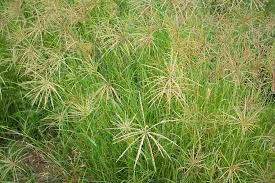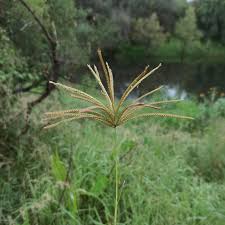Rhodes grass (Chloris gayana Kunth) is an important tropical grass widespread in tropical and subtropical countries. It is a useful forage for pasture and hay.
Rhodes grass is a perennial and annual tropical leafy grass that is about 1-3m in height and the roots very deep to about 4-5m. The leaves are linear (arranged) with flat or folded blades of about 12-50cm long x 10-20mm wide. The seed head has an open hand-shape 2-10 one-sided or double-sided, 4-15cm long,
Rhode last grass is usually a useful forage of normal or moderate to high quality. Chloris gayana originated from Africa and is now widespread in tropical and subtropical areas worldwide as it was later introduced into India, Pakistan, Australia, and the USA.
In Australia, it was introduced by their soldiers returning from war at the beginning of the 20th century. Rhodes grass has become one of the most widely sown subtropical grasses in Western Australia according to research.
Chloris gayana can either be vegetatively propagated or generated from seeds and can be sown alone or in combination with various other grasses such as Paspalum-diatatum, Setaria sphacelata, Cenchrus-ciliaris, or slower growing cultivars of guinea grass.
Read Also: Bermuda Grass (Cynodon dactylon) Complete Care Guide
Rhode Grass as Pasture and Hay

Rhodes grass is suited to both rain-fed and irrigated pastures. The grass requires good management, care, and can be improved with the use of fertilizer or manure application.
The nutritive value peaks, then bloom and then quickly stop. Therefore the nutritive value of Chloris gayana can also be improved through the addition of fertilizer and manure.
Rhodes grass is a persistent, drought-resistant, and highly productive species. The highest recorded yield is about 30-45tDM/ha while the average yield is in the 10-16tDM/ha range according to proven research.
Environmental Impact of Rhode Grass
Rhode grass is beneficial to our environment as it serves as soil re-vegetation, erosion control, and soil improver. Rhodes grass readily establishes and improves cover with 3-4 months of sowing.
Using it as a cover crop improves the soil structure, water infiltration, and water holding capacity. Its development lowers the soil temperature during summer and is used to make mulch to protect the soil from erosion in HAWAII.
Rhodes grass spread readily in a rain-forest in queens land (Australia), where it produces seeds and develops so quickly that it smoothies native species and forms almost pure stands.
Therefore Chloris gayana according to research was shown to overcome summer weeds and had been considered very helpful for controlling their developments (Australia).
Read Also: Pampas Grass (Cortaderia Selloana) Comprehensive Guide
Uses of Rhodes grass
Rhodes grass can be used as a permanent pasture or a short-medium term pasture. It can also be used to control erosion by the virtue of its spreading growth habit. It allows good hay if cut at or just before early flowering, then it provides better stand-over feeds than buffelgrass.
Rhodes grass is the main useful forage of moderate to high quality. It is gazed, cut for hay, or used as differed feeds, although it is not suitable for silage. It can form pure stands or can be sown with other grasses and legumes.
Rhode Grass Growing Guide

Rhodes grass is widely and highly adapted from soil PH 4.5 to 8.5. It has looping about 8 feet to 12 feet long, which drop down to create roots above the ground level.
It spreads readily by runners, useful for erosion control because of its strong runner growth and a vigorous root system. It can also be useful in controlling doing burr grass, it is easy to establish than many other tropical types of grass although the flurry seed is difficult to sow with conventional machinery.
Its low sugar starch levels allow to save unlimited continuous grazing, and this prevents insulin spikes in insulin-resistant and laminitis-prone horses.
Read Also: 4 Steps to help an Orange Tree Produce Sweet Oranges





